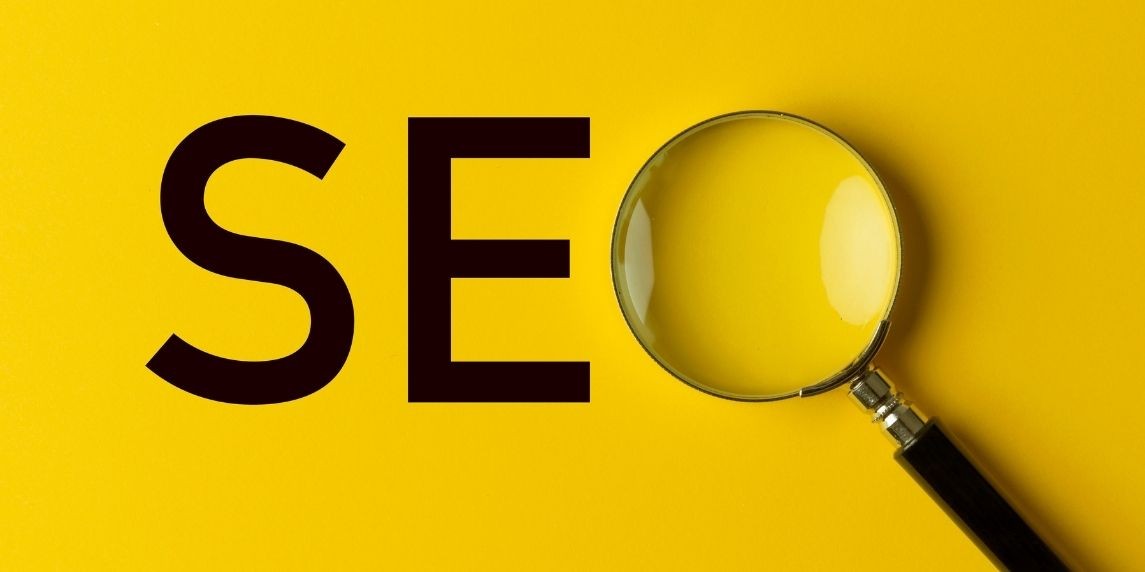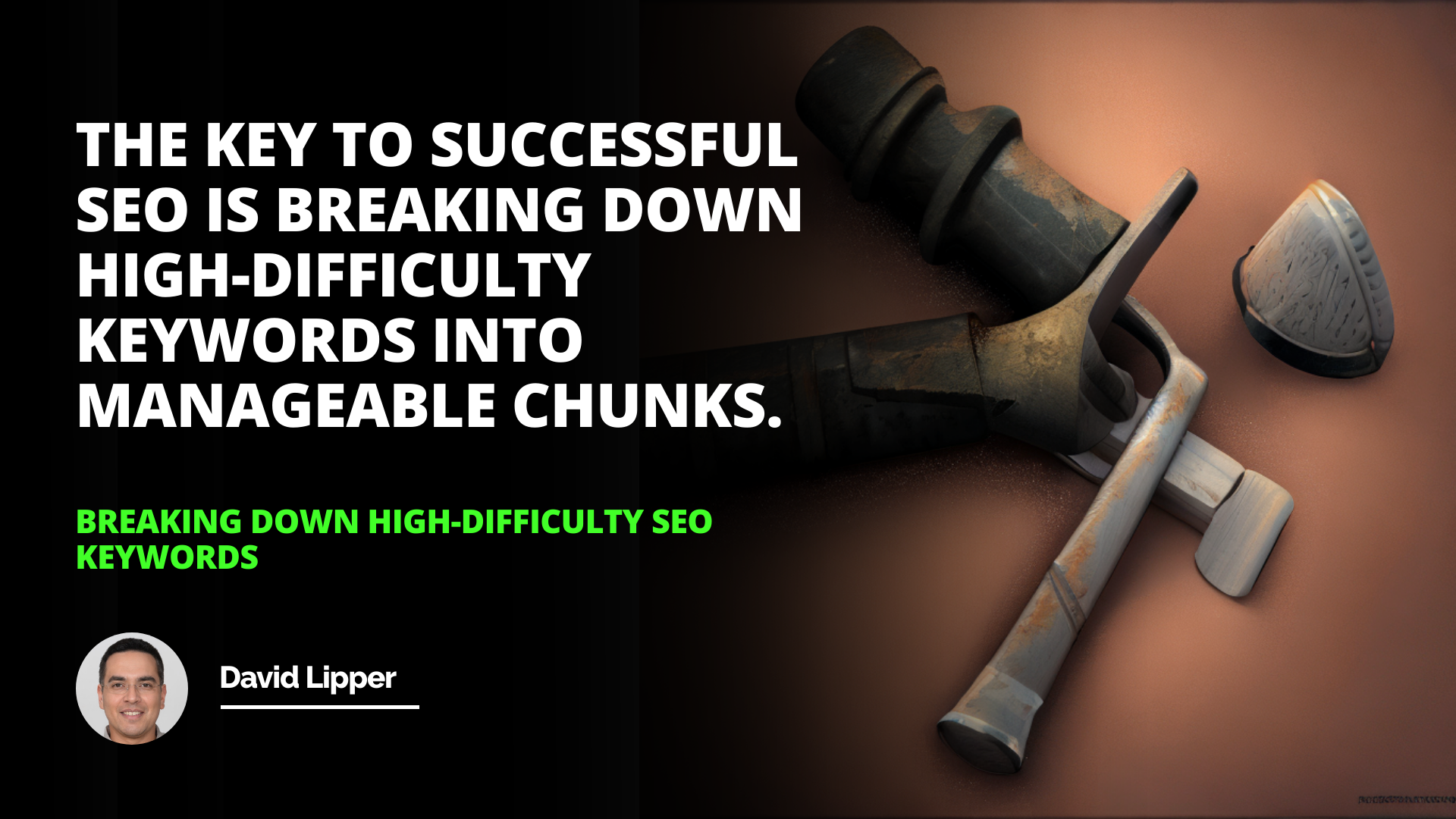
This article discussed the importance of keyword difficulty in SEO and the different ways to measure it. It also discussed the challenges of targeting high-difficulty keywords and the advantages of targeting long-tail keywords. It concluded by emphasizing the importance of knowing keyword difficulty to help decide whether to pursue a keyword or look for other options.
Introduction
Overview of Keyword Difficulty
High-Difficulty Keywords
Breaking Down Long-Tail Keywords
Conclusion
Introduction: Regarding SEO, keyword difficulty is an essential factor to consider. It measures how hard it is to rank for a given keyword in the search engine results pages (SERPs). Knowing the keyword difficulty can help you decide whether to pursue a keyword or to look for other options. In this article, we’ll look at the different ways to measure keyword difficulty and discuss the challenges of targeting high-difficulty keywords.
Overview of Keyword Difficulty
There are several ways to measure keyword difficulty. The most common approach is to use a keyword difficulty score from an SEO platform. These scores are based on various data points, such as search volume, number of results, backlink count, and paid ad CPC. On their own, each of these is a weak indicator of keyword competition, but in collective, they become more reliable.
High-Difficulty Keywords
High-difficulty keywords can be challenging to target. They tend to be high-volume but can be low-relevance. They will bring useless traffic with a high bounce rate and few conversions if they're too broad. If they are specific enough to generate leads, they are often too competitive to rank for.
Breaking Down Long-Tail Keywords
Long-tail keywords are more specific and often have lower keyword difficulty scores. They can be a great way to target high-volume keywords without competing with the big players. However, they can also be challenging to identify and target. To do so, you need to use keyword research tools to identify related terms and search intent. You can also use tools such as Google Trends to identify long-tail keywords with high search volume.
Conclusion: Keyword difficulty is an essential factor when targeting SEO keywords. High-difficulty keywords can be challenging to target and usually represent poor opportunities. On the other hand, long-tail keywords can be a great way to target high-volume keywords without competing with the big players. To do so, you need to use keyword research tools to identify related terms and search intent. Knowing the keyword difficulty can help you decide whether to pursue a keyword or to look for other options.
The key to successful SEO is breaking down high-difficulty keywords into manageable chunks.

Frequently Asked Questions
What are the benefits of breaking down high-difficulty SEO keywords?
Search engine optimization (SEO) is an integral part of any digital marketing strategy. It is an effective way to increase website traffic and improve visibility in search engine results pages (SERPs). However, SEO can be challenging to implement, especially when targeting high-difficulty keywords. Breaking down such keywords into smaller, more manageable components can be an effective way to optimize for these terms and reap the associated benefits.
One of the primary benefits of breaking down high-difficulty SEO keywords is the ability to create more targeted, relevant content. By breaking down difficult keywords into smaller components, it is possible to create more specific, targeted content that is more likely to be indexed by search engines. This targeted content can, in turn, generate more targeted traffic, as it will be more likely to appear on search engine results pages.
Additionally, breaking down high-difficulty SEO keywords can help increase website visibility. When targeting a problematic keyword, creating multiple pieces of content is often necessary to target it effectively. Breaking down the keyword into smaller components allows for creating multiple pieces of content that target different aspects of the keyword. This increases the chances of appearing in SERPs for various related searches, thus increasing website visibility.
Lastly, breaking down high-difficulty SEO keywords can help optimize the website in other ways. By creating content that targets specific keyword components, optimizing the website for related, long-tail keywords is possible. This can result in higher rankings for related terms, thus increasing website visibility and traffic.
In conclusion, breaking down high-difficulty SEO keywords can effectively optimize for these terms and reap the associated benefits. By creating more targeted, relevant content, increasing website visibility, and optimizing for related keywords, breaking down difficult keywords can help improve website rankings and increase website traffic.

How can I identify high-difficulty SEO keywords?
Many businesses looking to drive more organic traffic to their website have implemented search engine optimization (SEO) strategies. Part of any successful SEO plan is identifying high-difficulty keywords for targeting. High-difficulty keywords are more difficult to rank for than others due to the competition from other websites. To identify these keywords, there are a few key steps that need to be taken.
Conducting keyword research is one of the first steps in identifying high-difficulty keywords. This is the process of discovering which terms and phrases users type into search engines. Several tools are available to help with this process, such as Google’s Keyword Planner and Moz’s Keyword Explorer. These tools provide data on the search volume of a given keyword, as well as how competitive it is.
Once the keyword research has been completed, the next step is to analyze the competition. This involves looking at the websites currently ranking for the keyword and assessing how difficult it would be to compete against them. This can be done by looking at their domain authority and page authority, as well as the number of backlinks pointing to their website.
Finally, assessing the potential return on investment (ROI) for the keyword is essential. This can be done by looking at the keyword's estimated cost-per-click (CPC) and assessing the potential traffic it could bring to the website. It is also essential to consider the potential conversions generated from this traffic.
By following these steps, businesses can identify high-difficulty keywords and determine whether it is worth targeting them as part of their SEO strategy. While targeting high-difficulty keywords can be more challenging, the potential rewards can be significant.
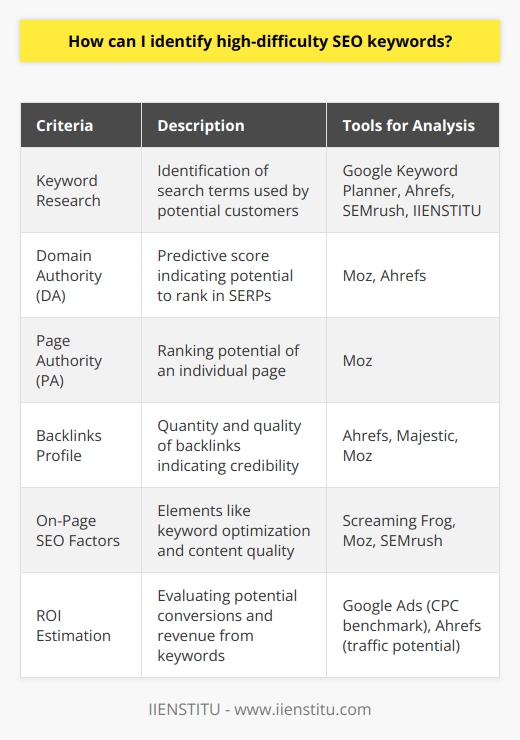
What strategies can I use to break down long-tail keywords?
This blog post will explore the strategies available for breaking down long-tail keywords. Long-tail keywords are phrases longer than usual and highly specific, such as “apple macbook air 13-inch.” These keywords are often more effective than shorter, more general terms regarding targeting search engine optimization (SEO) efforts. As such, it is essential to understand how to break down long-tail keywords to get the most out of them.
The first strategy to consider is to use keyword modifiers. These are words or phrases that can be added to the beginning or end of a keyword to make it more specific. For example, adding “buy” or “discount” to the beginning of the keyword “apple macbook air 13-inch” would make it more relevant for those searching for a discounted product. Similarly, adding “reviews” or “ratings” to the end of the keyword would make it more relevant to those looking for reviews or ratings.
Another strategy is to use a keyword analysis tool to break down long-tail keywords. These tools allow you to enter a keyword, and the tool will provide you with related keyword suggestions. This allows you to generate more targeted and specific keywords that may be more effective for your SEO efforts.
Finally, you can use a combination of both strategies. Start using a keyword analysis tool to generate related keywords, then add keyword modifiers to further narrow down the results. This will help you create a list of particular and targeted keywords that can be used in your SEO efforts.
In conclusion, there are several strategies available for breaking down long-tail keywords. Using keyword modifiers and analysis tools, you can generate a list of highly targeted and effective keywords that can be used in your SEO efforts.
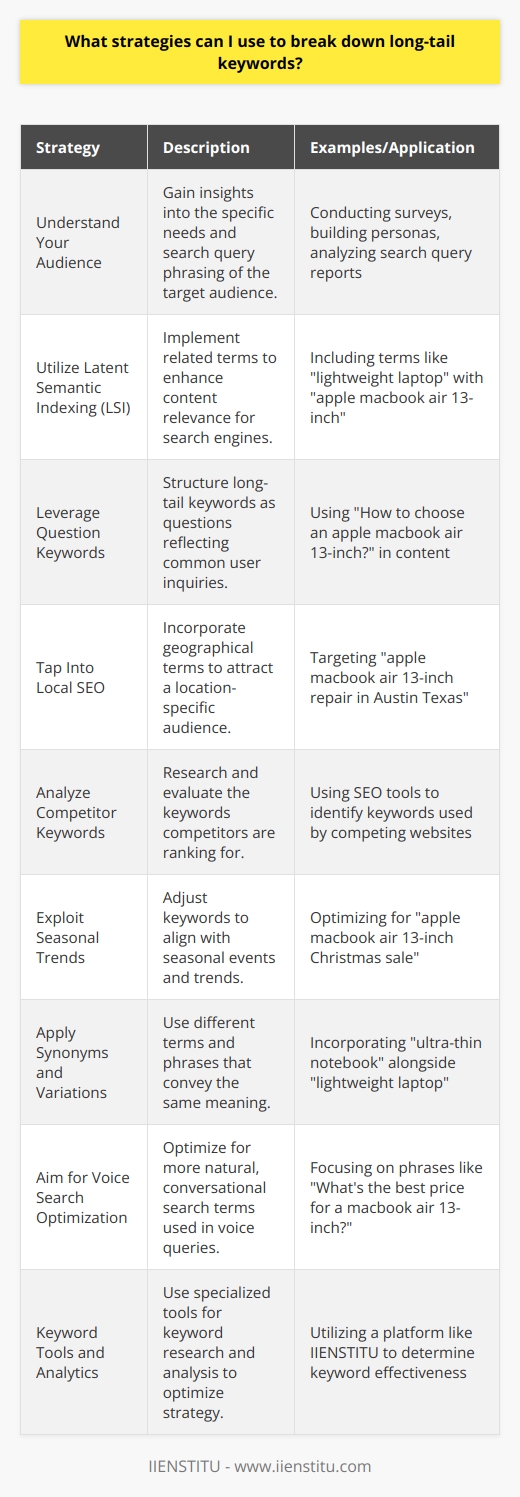
How do you rank high difficulty keywords?
Keyword Research and Selection
To rank high with difficult keywords, it is crucial to begin with an in-depth keyword research process. Start by identifying the most relevant and high-traffic phrases that your target audience is using to look for your content. By leveraging tools like Google's Keyword Planner and other third-party platforms, you can find and select competitive terms that can drive traffic to your website.
Optimized Content Creation
Next, create valuable content that directly addresses the search intent of your chosen difficult keywords. This involves crafting engaging, informative, and concise blog posts that provide readers with useful information, and additionally, implementing strategic keyword placements. Ensure that the primary keyword is present in the blog post's title, introduction, and first paragraph, but avoid over-optimization so your content remains user-centric.
On-page SEO Techniques
High-quality on-page SEO practices help boost your blog post's visibility for difficult keywords. Focus on optimizing your meta tags, including title, description, and header tags. Include the primary keyword and related terms in these tags to signal relevance to search engines, but always prioritize readability over keyword density. Additionally, format your content wisely by using subheadings, bullets, and short paragraphs to make it scannable and enjoyable to read.
Link Building Strategies
Generating high-quality backlinks from authoritative websites is vital for ranking high with difficult keywords, as it demonstrates credibility and trustworthiness to search engines. Develop mutually beneficial relationships with influential websites within your niche, and engage in guest posting or collaboration opportunities to create valuable content pieces. This will not only drive traffic and establish your reputation in the industry, but also provide backlinks that improve your search rankings.
User Experience and Engagement
To rank high for difficult keywords, a positive user experience is essential on your website. Ensure that your website is responsive and loads quickly, as slow-loading pages tend to increase bounce rates, thereby negatively impacting search rankings. Moreover, encourage user interaction by incorporating relevant calls-to-action, social sharing buttons, and commenting features on your blog posts to boost engagement.
In conclusion, to rank high for difficult keywords in a blog post, it is necessary to conduct effective keyword research, create optimized content, implement on-page SEO techniques, engage in link-building strategies, and prioritize user experience. By following these guidelines, you can enhance the visibility of your blog post on search engines and achieve better overall search performance.

What is SEO difficulty keyword difficulty?
Understanding SEO Keyword Difficulty
SEO keyword difficulty is a metric used to assess the competition level associated with ranking highly for a particular keyword on search engine results pages (SERPs). This concept is crucial when planning a successful search engine optimization (SEO) strategy, as it serves as a primary indicator of how challenging it may be to rank for specific keywords.
Assessing the Competition
In order to calculate keyword difficulty, various factors related to the competition are taken into consideration. These include the quality and quantity of backlinks pointing to the top-ranking pages, domain authority, and page authority. By evaluating these factors, one can determine the level of competition and the potential investment of time and resources needed to achieve high rankings for the desired keywords.
Importance in SEO Strategy
An effective SEO strategy incorporates keyword research that considers keyword difficulty. By selecting less competitive terms with high search volumes, website owners can potentially achieve better rankings and increased organic traffic. This approach is particularly beneficial for new websites or those with a limited online presence, as they may struggle to compete with well-established sites targeting highly competitive keywords.
Using Keyword Difficulty Tools
There are several tools available to measure and analyze keyword difficulty. These tools typically provide a numerical score, ranking the difficulty level from low to high. While various tools may use different methods to calculate the score, the objective remains the same: to help SEO practitioners identify keywords with achievable ranking potential.
Balancing Keyword Selection
While targeting low-competition keywords can yield improved rankings, it is important not to overlook the potential value of more competitive terms. High SEO keyword difficulty does not necessarily equate to an insurmountable barrier; rather, it may signify an opportunity to target valuable keywords with significant search volume. Striking a balance between targeting low- and high-competition keywords can maximize organic traffic and drive long-term growth.
In conclusion, understanding SEO keyword difficulty is essential for developing an effective strategy to improve search engine rankings. Utilizing keyword difficulty tools and analyzing the competition can help website owners identify optimal keywords for their target audience, ultimately leading to increased online visibility and organic traffic growth.
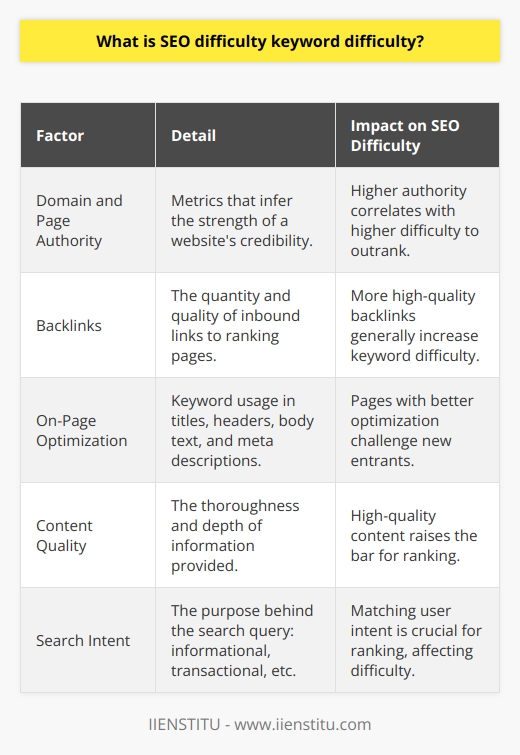
What factors do you consider to Analyse the keyword difficulty for a keyword?
Keyword Search Volume
A key factor to consider when analyzing keyword difficulty is the keyword's search volume, as it serves as an indicator of how often users enter this keyword in search engines. High search volume keywords typically attract more competition, making them harder to rank for.
Organic Click-Through Rate
The organic click-through rate (CTR) of a keyword shows the percentage of users who click on the search engine results for that keyword. A lower CTR signals poorer engagement with the content, making it potentially less competitive and easier to rank for.
Keyword Relevance
Another crucial aspect to consider is the relevance of a keyword to your content and target audience. A higher relevance increases the likelihood of users engaging with your content, resulting in better ranking opportunities for that specific keyword.
Domain Authority and Competition
Domain authority plays a significant role in keyword difficulty, as higher authority domains are generally more competitive within search results. Assessing the competition involves analyzing the top-ranking websites for a specific keyword and determining the potential gap that your content can fill.
Content Quality and User Experience
The quality of content and user experience provided by your rivals can also impact the difficulty of ranking for a keyword. By creating unique, high-quality content with engaging and user-friendly experiences, you can effectively stand out from your competitors and boost the chance of ranking higher for a keyword.
Backlink Profile
The backlink profile of a website is another essential factor to consider when analyzing keyword difficulty. A strong backlink portfolio attracts higher rankings in search results, while a weak portfolio makes it nearly impossible to compete with established websites. Therefore, targeting keywords with fewer strong backlinks might be easier to rank for.
Search Intent and Local SEO
Understanding the search intent of your target audience can help determine the complexity of ranking for a keyword. It is essential to create content that caters to the specific needs of your audience to meet their search intent accurately. Additionally, local SEO can influence the difficulty of a keyword, so focusing on geo-specific keywords can help improve your website's visibility.
In conclusion, to accurately analyze keyword difficulty, several factors such as search volume, organic CTR, keyword relevance, domain authority, competition, content quality, user experience, backlink profile, search intent, and local SEO should be considered. By comprehensively evaluating these elements, you can effectively identify keywords with the best potential for improving your content's ranking in search results.

Is SEO difficulty the same as keyword difficulty?
Difference Between SEO and Keyword Difficulty
Understanding the Concepts:
In order to determine whether SEO difficulty and keyword difficulty are the same, it is crucial to understand the distinctions between these two concepts. SEO, or Search Engine Optimization, involves various strategies and techniques that aim to improve a website's visibility and ranking on search engines. On the other hand, keyword difficulty refers to the level of competition surrounding a specific keyword or phrase, measured by the number of websites attempting to rank for that particular term.
Ranking Factors and SEO Difficulty:
SEO difficulty takes into account an array of factors that influence a website's search engine ranking, such as the quality and quantity of backlinks, on-page optimization, and the domain's age and authority. In essence, SEO difficulty is a more comprehensive concept that encompasses all aspects of optimizing a website for search engines.
Keyword Difficulty and Competition:
Keyword difficulty, in contrast, specifically addresses the competition surrounding a given keyword or phrase, which determines how challenging it might be to achieve high search engine rankings for that term. Factors affecting keyword difficulty include the number of websites targeting the keyword, competitors' domain authority, and backlink profiles. The higher the keyword difficulty score, the more competitive the landscape for that keyword.
Inextricably Linked Components:
Although SEO difficulty and keyword difficulty are distinct concepts, they are inextricably linked. A website's overall SEO difficulty is influenced in part by the keyword difficulty of the terms it targets. Furthermore, optimizing a website for lower competition keywords could enhance its overall SEO by improving its search engine rankings.
Conclusion:
While SEO difficulty and keyword difficulty are distinct concepts, they are interconnected components of a website's search engine optimization. SEO difficulty considers various factors that determine a website's ranking on search engines, whereas keyword difficulty measures the level of competition for a specific keyword or phrase. Understanding the intricacies of these concepts can help in crafting targeted SEO strategies and improving a website's search engine performance.
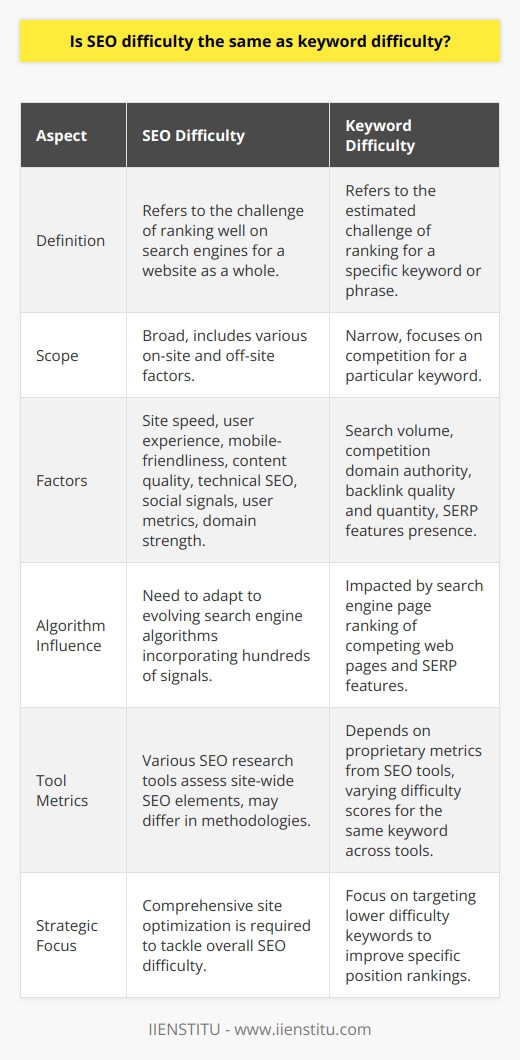
How do I check SEO difficulty of a keyword?
Understanding SEO Difficulty of Keywords
**Assessing Keywords' Effectiveness**
To determine the search engine optimization (SEO) difficulty of a keyword, one must scrutinize its several attributes, such as search volume, competitiveness, and relevance. It's crucial to understand whether a keyword is effective in increasing a website's visibility and attracting organic traffic before incorporating it into a content strategy.
**Keyword Research Tools**
Keyword research tools are essential for obtaining reliable data on the SEO difficulty of a particular keyword. Some popular options are Google Ads Keyword Planner, SEMrush, Ahrefs, and Moz. These tools deliver valuable insights on search volume, cost per click (CPC), and competitiveness, crucial metrics for assessing SEO difficulty.
**Search Volume and Competition**
Identifying the SEO difficulty of a keyword begins with examining search volume and competition. Higher search volume indicates that the keyword is popular among users and has a greater potential for driving organic traffic. However, it also implies higher competition, making it harder for content to rank and outcompete other sites vying for the same keyword. Therefore, striking a balance between high search volume and low competition is essential.
**Keyword Difficulty Score**
Many SEO tools assign a keyword difficulty score (KD) to keywords, representing a metric that amalgamates the competitive landscape of a keyword. The score typically ranges from 0 to 100, with higher values denoting greater difficulty. SEO difficulty scores are beneficial for comparing keywords and determining which are worth targeting.
**Long-tail Keywords**
Focusing on long-tail keywords – phrases comprising three or more words – can be a more feasible approach to targeting competitive niches. These keywords often have lower search volumes but higher conversion rates and less competition, making it easier for content to rank.
**Analyzing the Top-ranked Content**
To further gauge a keyword's SEO difficulty, analyze the top 10 search results for that keyword. Factors like domain authority, content quality, and social signals provide a better understanding of the benchmark required to outrank competitors.
In summary, checking the SEO difficulty of a keyword requires a combination of research tools and manual analysis. Assessing search volume, competition, keyword difficulty scores, long-tail keyword potential, and top-ranked content provide a comprehensive view of a keyword's potential effectiveness for a blog post.
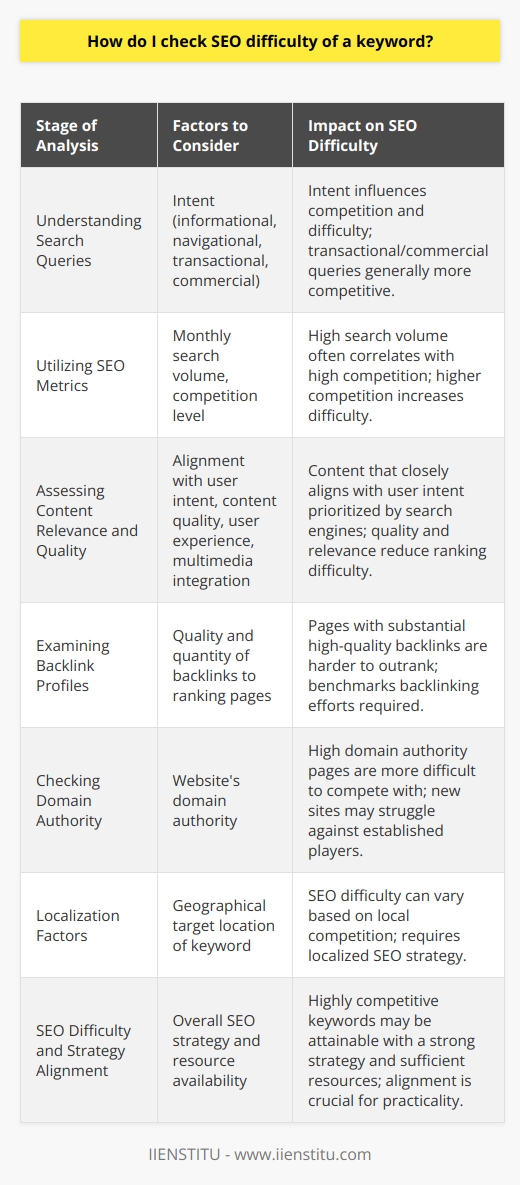
What are the 4 types of SEO keywords?
Keyword Categories in SEO
Primary Keywords
Primary keywords, also known as focus keywords, are the main terms that directly and specifically describe the content of a web page. These keywords are typically targeted with the most emphasis, as they are essential for connecting users and search engines to the blog post. Since primary keywords are the foundation for the page's central topic, they should be relevant to the audience and strategically placed in areas such as the title, meta descriptions, headings, and body paragraphs.
Long-Tail Keywords
Long-tail keywords consist of three or more words that users often input in search engines to narrow down search results. These keywords usually have lower search volumes and less competition because they focus on niche topics. By incorporating long-tail keywords in a blog post, the content becomes more specific, which allows it to rank higher in search results and increase the probability of targeting an audience with a higher intent to engage or convert.
Synonyms and Variations
Synonyms and variations are alternative words or phrases that share a similar meaning or concept with the primary keyword. By including these terms, bloggers can enhance the semantic relevance of their content, which plays an important role in search engine algorithms. Using synonyms and variations can help to improve the readability of the blog post, as it prevents the overuse of the primary keyword and generates more natural-sounding content for the users.
LSI Keywords
Latent Semantic Indexing (LSI) keywords are terms and phrases that are contextually related to the primary keyword, but not necessarily synonyms. These terms may have a topical or conceptual connection but can also be semantically distant from the focus keyword. Integrating LSI keywords in a blog post helps search engines understand the content more thoroughly and enables the content to rank for a wider range of related searches.
In conclusion, the four types of SEO keywords—primary keywords, long-tail keywords, synonyms and variations, and LSI keywords—contribute to the optimization of blog content for both users and search engines. Employing a balanced and strategic combination of these keywords enhances the readability, relevance, and ranking potential of a blog post, ultimately leading to increased visibility and user engagement.

